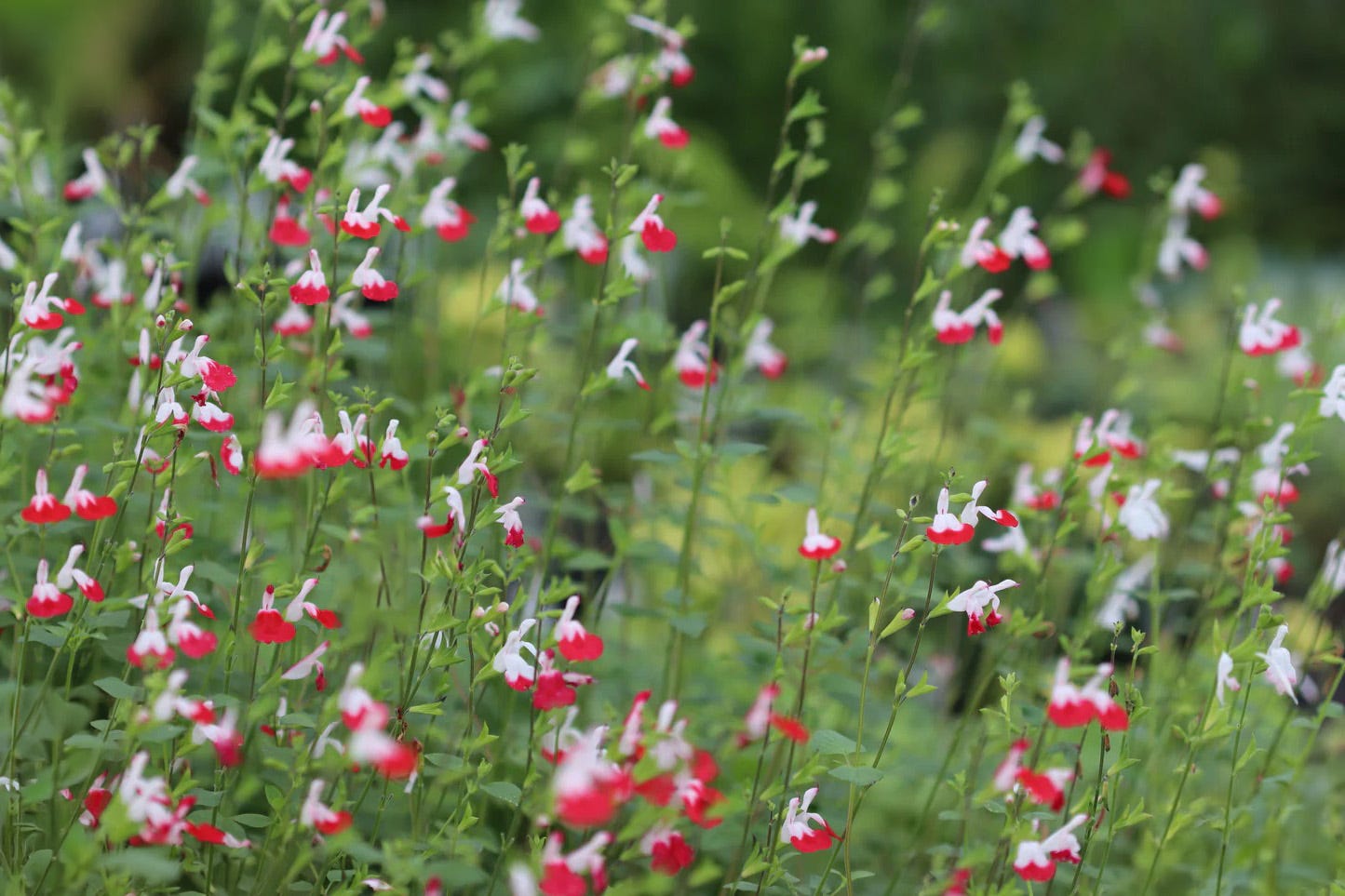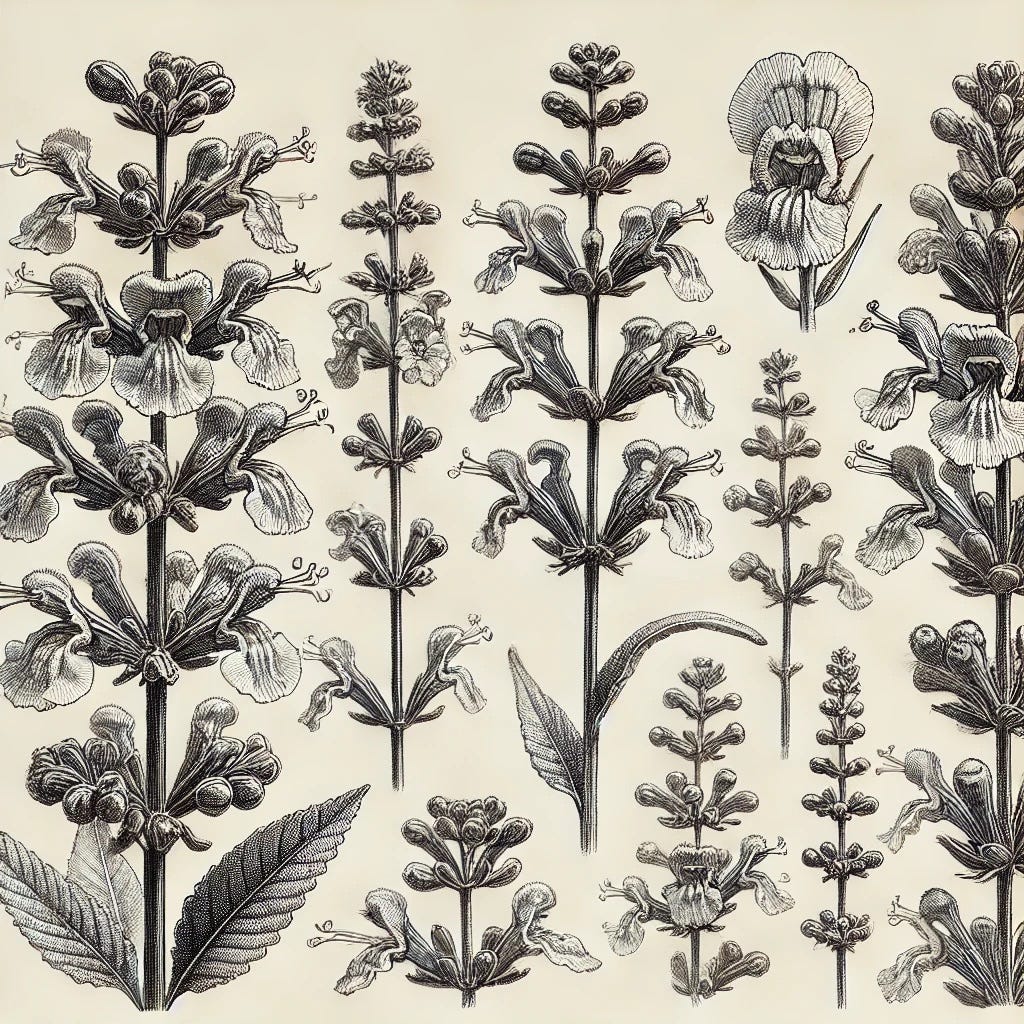NAPA VALLEY, Calif. — What plant genus has square branches, comes in an enormous variety of sizes and flower types, and is drought-tolerant once established? The answer is salvia, a large group whose members we commonly refer to as sages.
Salvias are found in many locations throughout the world. Some are perennials, while others are annuals. It is the largest genus in the Lamiaceae family, which includes a lot of fragrant herbs such as mint, thyme and lavender. Botanists estimate that there are anywhere from 700 to 3,000 species of salvia.
Local nurseries offer a wide variety of salvias. I have collected several of them and find tempting new varieties in the stores every year. They bloom in a wide range of colors that include red, blue, purple, yellow and white.
Salvia microphylla “Hot Lips” came to the United States when Richard Turner, the former editor of Pacific Horticulture magazine, noticed the unfamiliar plant in a pot at some friends’ home in Mexico. The friends’ housekeeper, an avid gardener, had given it to them as a housewarming gift. Turner snipped some cuttings and on his return to California gave them to the experts at San Francisco’s Strybing Arboretum for propagation. Christened “Hot Lips,” the variety has enjoyed tremendous success.
The flowers on this salvia can be all white, all red or a combination. Bees love the nectar, which they gather by drilling a small hole in the back of the flower rather than entering at the opening. I have watched them do this.
I have four different plantings of “Hot Lips.” I started with a 1-gallon can, and the plant has spread by itself. It is drought-tolerant and a pollinator magnet. It is easy to propagate; I have been spreading it around to my neighbors. On a visit to Dublin, Ireland, I saw “Hot Lips” in a botanical garden, confirming that it is widespread.
Another nice feature of salvias — and one reason I prize them in my garden — is that deer, rabbits and gophers leave them alone. If you have these critters in your area, you know how important it is to choose plants they don’t like. On more than one occasion I have watched a plant disappear below ground or have found a dead plant completely chewed off at the base.
A note about Jerusalem sage (Phlomis fruticosa), which I love. My neighbor has a beautiful stand of this plant, which has furry gray-green leaves and yellow flowers that seem to float above them. However, despite its common name, Jerusalem sage is not a true sage. As the botanical name tells us, it’s in another genus entirely.
Occasionally I dig up some of my Hot Lips, divide it and replant the sections into small pots to give away. If you do this, be sure to trim the tops of each division so the disturbed roots have less to support until they reestablish. As the roots take hold in their new home, new leaves will sprout. When you see that new growth, plant in well-draining soil and keep it moist until you know it has settled in.
I have also propagated salvias from cuttings, either in a cloning device or by planting the cuttings in a mixture of sharp sand and perlite. Once they take root I move them to small pots. Salvias need to be pruned or deadheaded a few times a year. Cut a foot or two off the tops and watch them regrow. Pruning encourages rebloom because it prevents the plant from setting seed.
Many salvias in nurseries are hybrids, created by crossing two different parents. Some of these hybrids have unusual flowers yet still have all the good features of salvias: drought tolerance, continuous bloom, attraction for pollinators. Plant pollinators are in decline and need all the good-tasting nectar they can find.
Most salvia will do fine in our mild Napa Valley winters and don’t need much water. They thrive in the same conditions as lavender, and the two are often planted together.
I would suggest which salvia varieties to buy, but I like them all. Consult local nurseries and online catalogs and just pick the colors you like. With salvias, you can hardly go wrong.
Workshop: Join UC Master Gardeners of Napa County for “Succulent/Dry Garden: Double Your Pleasure — Double Your Fun” on Saturday, July 27, from 10 a.m. to noon at Las Flores Learning Garden, 4300 Linda Vista Ave., Napa. Do you know the five most common ways succulents reproduce? Learn their secrets and how you can increase your plant collection or add to your low-water landscape through succulent plant propagation. Register here.
Library Talk: Join UC Master Gardeners of Napa County and Napa County Library for a talk on “Fabulous Ferns, Indoors and Out” on Thursday, Aug. 1, from 7 to 8 p.m. via Zoom. Ferns are an accommodating family of plants that range in size from tiny to behemoth. Some species grow in air and others in water, as well as in just about any type of soil. Enjoy an overview of these remarkable plants and find the perfect one for your space. Register to receive the Zoom link.
Fall Faire: Join the UC Master Gardeners of Napa County for an entertaining and educational event on Saturday, Sept. 28, from 1 to 4 p.m., outdoors at the University of California Cooperative Extension, 1710 Soscol Ave., Napa. Enjoy exhibits on composting, monarch butterflies, succulents, water conservation, bees and more. The program includes activities for kids, a scarecrow contest, giveaways and music. Admission is free.
Become a Master Gardener Volunteer: UC Master Gardeners of Napa County is now accepting applications for the Class of 2025. Visit napamg.ucanr.edu to read the informational brochure, then register to attend a mandatory information session for applicants. Application deadline is 5 p.m. on Sept. 25.
Help Desk: The Master Gardener Help Desk is available to answer your garden questions on Mondays and Fridays from 10 a.m. until 1 p.m. at the University of California Cooperative Extension Office, 1710 Soscol Ave., Suite 4, Napa. Or send your questions to mastergardeners@countyofnapa.org. Include your name, address, phone number and a brief description. For best results attach a photo.
If today's story captured your interest, explore these related articles:
Penny Pawl is a UC Master Gardener of Napa County.








Clearly, the Pachamama (Earth Mother) is with you! thanks for all the information.
Penny, you wrote about some of my favorite plants! The 'hot lips' I have is a magnet for carpenter bees and bumblebees bees! I plan to plant more varieties. Thanks!